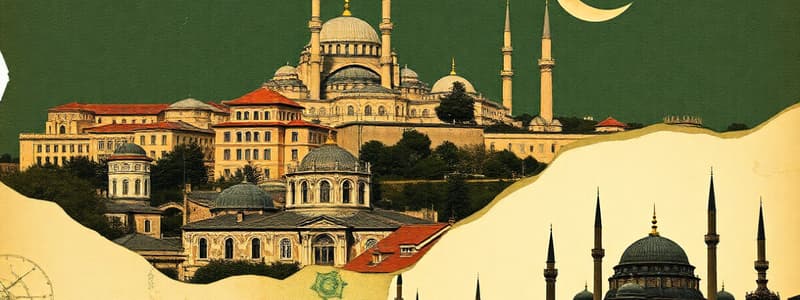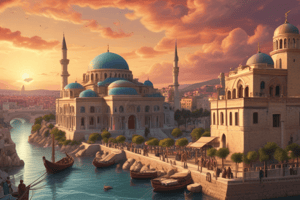Podcast
Questions and Answers
Constantinople's geographic location contributed significantly to its importance primarily because:
Constantinople's geographic location contributed significantly to its importance primarily because:
- It fostered a homogenous culture, minimizing internal conflicts and promoting unity.
- It was strategically positioned for trade between Asia and Europe and easily defended due to its surrounding waters. (correct)
- It was distant from other major civilizations, enabling it to develop in isolation.
- It allowed the emperor to easily control all four corners of the divided Roman Empire.
How did the establishment of Constantinople by Constantine I impact the Roman Empire?
How did the establishment of Constantinople by Constantine I impact the Roman Empire?
- It initiated a series of religious reforms that completely dissolved the traditional Roman pantheon.
- It led to the immediate decline of the Western Roman Empire due to resource reallocation.
- It marked the definitive split of the empire into solely eastern and western halves, ensuring their independent governance.
- It shifted the empire's power center eastward, reuniting it under a single ruler after a period of division. (correct)
Which of the following describes a key characteristic of early Byzantine society in Constantinople?
Which of the following describes a key characteristic of early Byzantine society in Constantinople?
- Strict segregation and limited social mobility due to rigid class and ethnic hierarchies.
- A welcoming environment with social mobility for those willing to adopt Greek customs and names. (correct)
- A strong emphasis on isolationism, limiting the influence of foreign cultures and traditions.
- Exclusive focus on maritime trade, neglecting agricultural and artisanal sectors.
What role did Byzantium play before Constantine I established Constantinople?
What role did Byzantium play before Constantine I established Constantinople?
How did the division of the Roman Empire by Diocletian affect Byzantium?
How did the division of the Roman Empire by Diocletian affect Byzantium?
Constantine's decision to establish Constantinople as 'New Rome' was primarily driven by which of the following strategic considerations?
Constantine's decision to establish Constantinople as 'New Rome' was primarily driven by which of the following strategic considerations?
How did Constantine attempt to integrate the culture and identity of 'New Rome' with the existing Roman Empire?
How did Constantine attempt to integrate the culture and identity of 'New Rome' with the existing Roman Empire?
What impact did making Constantinople the center of Christianity have on the Byzantine Empire?
What impact did making Constantinople the center of Christianity have on the Byzantine Empire?
How did Constantinople's geographical location influence its economic prosperity?
How did Constantinople's geographical location influence its economic prosperity?
Which architectural innovations or features of Constantinople's structures, such as the Hagia Sophia and the Hippodrome, demonstrate the city's cultural and technological advancements?
Which architectural innovations or features of Constantinople's structures, such as the Hagia Sophia and the Hippodrome, demonstrate the city's cultural and technological advancements?
Flashcards
Constantinople
Constantinople
Capital of the Byzantine Empire, now Istanbul, a key trade center between Asia and Europe.
Why Constantinople's Location Was Key
Why Constantinople's Location Was Key
It was strategically located between Europe and Asia, surrounded on three sides by water, promoting trade and defense.
Constantinople's Origins
Constantinople's Origins
Originally Byzantium, it was renamed after Emperor Constantine I who made it the capital of the Roman Empire's eastern part.
Constantinople's Role
Constantinople's Role
Signup and view all the flashcards
Constantine the Great
Constantine the Great
Signup and view all the flashcards
Why 'New Rome'?
Why 'New Rome'?
Signup and view all the flashcards
Why Constantinople?
Why Constantinople?
Signup and view all the flashcards
Byzantine Bureaucracy
Byzantine Bureaucracy
Signup and view all the flashcards
Constantinople Trade Hub
Constantinople Trade Hub
Signup and view all the flashcards
Hagia Sophia
Hagia Sophia
Signup and view all the flashcards
Study Notes
- Constantinople, now Istanbul, was the Byzantine Empire's capital and a historically significant city.
- Its geographic location, surrounded on three sides by water, made it a unique trade hub.
History of Constantinople
- Constantinople was a vital city in the Roman Empire.
- It was later named after Emperor Constantine I, the first Byzantine emperor.
- Founded in 330 A.D., previously known as Byzantium, it served as the center of the Byzantine Empire, the Roman Empire's eastern part.
- Its location between Asia and Europe and its large port on three sides boosted commerce and defense.
- Byzantium was a trade center between Asia and Europe, influenced by events from both regions.
- Early Byzantium accepted people from diverse backgrounds, with social mobility attainable by converting names to Greek.
- Over time, racial, class, and ethnic differences caused internal conflict.
Establishment of Constantinople
- Constantinople was a conflict center between Athens and Sparta for resource control.
- Septimus Severus rebuilt it in 192 C.E. after destroying it, incorporating it into the Roman Empire.
- Diocletian divided the Roman Empire into four parts at the end of the second century C.E. and took control of Byzantium.
- Emperor Constantine I, or Constantine the Great, founded Constantinople, initially calling it New Rome.
- In 324 C.E., he moved his seat of power there after reuniting the Roman Empire.
- Constantine built strong defenses, including a harbor chain against naval invasions and walls against land forces.
- He increased the population by providing drinking water via a large aqueduct and food, aiming to spread the New Rome lifestyle to civilize the Eastern Romans whom he considered barbarians.
Why Was Constantinople Called New Rome?
- Constantine initially named it Nova Roma, or New Rome, to link himself to the Roman Empire's power.
- The Byzantine Empire began when Constantine moved to New Rome due to:
- Reduced corruption
- Proximity to the Persians for defense, invasion, and subjugation
- Ability to house a large population without overcrowding
- He established a bureaucracy with regional magistrates and administrative officersHierarchical administrative officers that report to him.
- This bureaucracy controlled civil matters, but the emperor retained military decision-making.
- Constantinople established dynastic traditions and family inheritance of responsibilities.
- Byzantine children were restricted to farming, while bureaucratic offices and the position of emperor passed down regardless of competence.
The Founding of the Byzantine Empire
- Constantinople became the center of Christianity.
- Emperor Constantine authorized it as the official religion of the New Roman Empire.
- He made himself head of the Catholic Church, entrenching Roman Imperial authority, a factor in the Catholic Church's dissolution and weakening the Byzantine Empire.
- The Byzantine Emperor lost control of the Western territories of the New Roman Empire.
- Constantinople thrived until the Ottoman Turks destroyed it in 1453.
- The Fourth Crusade in 1204 and the Black Death of the 1340s facilitated the Ottoman's success.
The Center of the Byzantine Empire
- As the Byzantine Empire's center, Constantinople possessed vast wealth and allowed the emperor to lead the Eastern territories from a central location.
- It was a site of significant architectural and cultural achievements.
Constantinople Trade
- Constantinople was on the Silk Road, a trade hub between Europe and Asia.
- Its defensibility made it a popular destination for traders, leading to vast wealth accumulation.
- Citizens traded with those they considered barbarians.
- Constantinople supplied silk to countries like Egypt and China.
- Other goods included pottery, linen, crops, and precious metals.
- Although trade brought prosperity to the empire, traders were not highly regarded.
Constantinople Architecture
- Hagia Sophia: Commissioned by Justinian, designed as the largest basilica in the Byzantine Empire, using revolutionary architectural techniques.
- The Ottoman Turks converted it into a mosque due to its impressive structure.
- Hippodrome: Built by Septimus Severus after destroying Byzantium, it was used for chariot racing and public events.
- It was the largest arena globally, holding over sixty thousand people.
- Column of Constantine: A monument to Constantine and the foundation of Constantinople.
- It was transformed into a monument to the power of God after Constantine's death.
- Different powers saw the column as a symbol of their dominance.
Studying That Suits You
Use AI to generate personalized quizzes and flashcards to suit your learning preferences.



